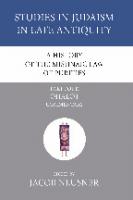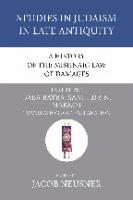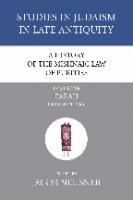A History of the Mishnaic Law of Damages, Part 4: Shebuot, Eduyot, Abodah Zarah, Abot, Horayot 1556353685, 9781556353680
The history of Jews from the period of the Second Temple to the rise of Islam. From 'A History of the Mishnaic Law
129 69 22MB
English Pages 310 [311] Year 2007
Cover
Title Page
Copyright
Dedication
TABLE OF CONTENTS
PREFACE
Recommend Papers

- Author / Uploaded
- Jacob Neusner (editor)
File loading please wait...
Citation preview
A HISTORY OF THE MISHNAIC LAW OF DAMAGES PART FOUR
STUDIES IN JUDAISM IN LATE ANTIQUITY EDITED BY
JACOB NEUSNER VOLUME THIRTY-FIVE A HISTORY OF THE MISHNAIC LAW OF DAMAGES PART FOUR
A HISTORY OF THE MISHNAIC LAW OF DAMAGES BY
JACOB NEUSNER University Professor The Ungerleider Distinguished Scholar of Judaic Studies Brown University
PART FOUR
SHEBUOT, EDUYOT, ABODAH ZARAH, ABOT, HORAYOT. TRANSLATION
AND EXPLANATION
Wipf&Stock PUBLISHERS Eugene,Oregon
Wipf and Stock Publishers 199 W 8th Ave, Suite 3 Eugene, OR 97401 A History of the Mishnaic Law of Damages, Part 4 Shebuot, Eduyot, Abodah Zarah, Abot, Horayot By Neusner, Jacob Copyright©1985 by Neusner, Jacob ISBN 13: 978-1-55635-368-0 ISBN 10: 1-55635-368-5 Publication date 3/20/2007 Previously published by E. J. Brill, 1985
For Glen W. Bowersock who graces the scholarly world by his integrity and decency.
TABLE OF CONTENTS Preface.......................................................................... 1x Abbreviations and Bibliography . . . . . . . . . . . . . . . . . . . . . . . . . . . . . . . . . . . . . . . . . . . xvn Transliterations ............................................................... xxxnr SHEBUOT
I. II. III. IV. V. VI. VII. VIII. IX.
Introduction to Shebuot .. .. .. .. . . . .. .. .. . . . .. . . . . .. .. .. . . . .. . . Shebuot Chapter One.......................................... Shebuot Chapter Two .. .. . .. .. . .. .. .. .. . .. . ... .. .. .. .. . .. .. . .. Shebuot Chapter Three........................................ Shebuot Chapter Four......................................... Shebuot Chapter Five.......................................... Shebuot Chapter Six........................................... Shebuot Chapter Seven........................................ Shebuot Chapter Eight . . . . . . . . . . . . . . . . . . . . . . . . . . . . . . . . . . . . . . . . .
3 8 18 22 29 41 51 62 70
EDUYOT X. XI. XII. XIII. XIV. XV. XVI. XVII. XVIII.
Introduction to Eduyot .. . . . . . . .. . .. . . .. . . . .. .. .. .. . . .. . . . .. . .. Eduyot Chapter One........................................... Eduyot Chapter Two........................................... Eduyot Chapter Three......................................... Eduyot Chapter Four.......................................... Eduyot Chapter Five . . . . . . . . . . . . . . . . . . . . . . . . . . . . . . . . . . . . . . . . . . . Eduyot Chapter Six............................................ Eduyot Chapter Seven......................................... Eduyot Chapter Eight..........................................
79 81 92 101 107 114 121 126 130
ABODAH ZARAH
XIX. XX. XXI. XXII. XXIII. XXIV.
Introduction to Abodah Abodah Zarah Chapter Abodah Zarah Chapter Abodah Zarah Chapter Abodah Zarah Chapter Abodah Zarah Chapter
Zarah............................... One.................................. Two.................................. Three................................ Four . . . . . . . . . . . . . . . . . . . . . . . . . . . . . . . . . Five..................................
137 142 154 169 179 193
ABOT XXV. XXVI.
Introduction to Abot. Abot Chapter One.................. Abot ChapterTwo..............................................
205 210
VIII
TABLE
OF CONTENTS
XXVII. Abot Chapter Three.. . . . . . . . . . . . . . . . . . . . . . . . . . . . . . . . . . . . . . . . . . . 215 XX.VIII. Abot Chapter Four . . . . . . . . . . . . . . . . . . . . . . . . . . . . . . . . . . . . . . . . . . . . . 220 XXIX. Abot Chapter Five.............................................. 225 HORAYOT
XXX. XXXI. XX.XII. XX.XIII.
Introduction to Horayot....................................... Horayot Chapter One . . . . . . . . . . . . . . . . . . . . . . . . . . . . . . . . . . . . . . . . . Horayot Chapter Two . . . . . . . . . . . . . . . . . . . . . . . . . . . . . . . . . . . . . . . . . Horayot Chapter Three . . . . . . . . . . . . . . . . . . . . . . . . . . . . . . . . . . . . . . .
Index............................................................................
235 239 248 254 262
PREFACE While what I have to say about three of the five tractates presented in this book flows from established methods and produces expected result, the treatment of the other two does not. Since the thesis of the project, treating the Mishnaic divisions of Women, Appointed Times, and Damages, is that Mishnah constitutes its own best commentary, and that Mishnah's commentary is effected through its formal traits, Eduyot and Abot form a problem. Specifically, neither tractate presents a fertile field for the demonstration of the stated thesis or for the opposite. Eduyot is a hodge-podge of materials generally located elsewhere in Mishnah. Its framers merely express their own theory of the organization of Mishnaic pericopae and do not pretend to play a part in the formation of the pericopae which they organize. Consequently, there is no close interplay between redaction, formulation, form, and meaning. It further follows that the thesis of this commentary is simply irrelevant to that tractate. Abot, for its part, scarcely intersects with the rest of the division in which it stands, let alone with Mishnah as a whole. \Vhile its formal traits are blatant and pronounced, they bear no clear relationship at all to what is expressed, because they are wholly external to the meaning of the passages. In fact, the function of the form of Abot is solely redactional. In no way does form serve as part of the internal exegesis of the pericope. It will follow that what I have to say about the materials of Eduyot and Abot is brief and perfunctory. In the case of the former, I have only to point out the obvious traits of redaction, which are made explicit within the redactional framework itself, as well as to supply the main crossreferences. In the case of the latter, I propose chiefly to call attention to the equally obvious fact that already-framed sayings are strung together in a coarse and self-evident pattern. Proof of the correctness of my exegetical thesis, therefore, derives from those points at which the thesis is irrelevant and from the simple fact that, where the thesis fails, there-in the contrast-we see its power. Let me now turn to the explanation of what I believe I have accomplished in this rather substantial exercise in translation and explanation, which, happily, draws to a close in the present volume. The character of this translation and explanation in detail expresses the purpose of the larger work of which it is part. To present a history of the Mishnaic law, I have first of all to give an account of the document itself, first of all to state what I believe Mishnah says, in a rendition, in English, as close to the formal and syn tactical character of the Hebrew as English
X
PREFACE
permits. This I do in the translation, which itself is a commentary in its word-choices and patterns and its version of the division of sentences into stichs, of paragraphs into sentences, and of chapters into paragraphs. (But this last depends, for the convenience of the reader, on the printed text of I:Janokh Albeck.) The translation makes no important contribution to the explanation of realia or the identification of various places, persons, and things, mentioned in the document. What it does contribute is the first translation of a rabbinic document to take full and faithful account of the rigidly formalized, public and anonymous character of Mishnaic language. I provide complete form-analytical translations of Mishnah and ofTosefta. The explanationis rather different from any of its predecessors, so different that it must be called "explanation." For if what have been done in the past are called commentaries, this cannot be represented as a commentary at all. What I do not say invariably is more important than what I choose to discuss. By radically revising and abbreviating the established exegetical agendum, I believe I have made my richest contribution to the interpretation of Mishnah. This is in two aspects. First, as I said at the outset, I have tried to force Mishnah to serve as its own commentary. I do so by relying heavily upon those formal and even substantive traits of the document which serve to provide a clear account ofMishnah's meaning and message. I pay careful attention to matters of form and formulation. We shall see time and again that principally through setting up a contrast, or placing of a phrase for emphasis, or other obvious linguistic and syntactical modes of highlighting its meaning, Mishnah serves as its own first, and therefore best, commentary. Second, I have revised what I believe to be the definition of those issues appropriate to, and even acceptable for, exegesis of Mishnah in particular. I treat Mishnah as a singular document of its particular period. This last point requires some amplification. There are two sides to the problem of explaining what Mishnah means. Both of them are generated by one absolutely false conception, or, more accurately, misleading analogy. The first problem is the bringing to Mishnah of issues clearly extraneous to its original meaning. This set of comments plainly is needless because the issues are generated by later problems and questions. They are quite naturally addressed to Mishnah, however, by people who assume Mishnah speaks to them and therefore must address issues of importance to them. This ahistorical approach is valid for the generating and unfolding of law. But it is not correct for the interpretation of what Mishnah as a concrete document meant to the particular people who made it up.
PREFACE
XI
The second problem is corollary, namely, the placing of Mishnah's materials into the context of a whole legal system. When Mishnah is read in a larger framework than Mishnah, we are prevented from seeing Mishnah's materials as a coherent corpus on their own. I propose to state, and, later, historically to account for the unfolding of, the law of Mishnah in particular. If we assume that Mishnah constitutes a single document-and the internally harmonious formal and intellectual traits of Mishnah require that we make that assumption_:then we have no choice but to honor the limits of the documen.t when attempting to describe and interpret it. Until now all commentators to Mishnah have taken only a limited interest in the shape and structure of Mishnah itself. It goes without saying, none has asked a historical-exegetical question(' 'What does this mean to the person who originally said it and who did not know what his successors would want to say about it?'') to begin with. For their problem was a different one. It was dictated by a social and intellectual task quite separate from ours. They addressed themselves not to the exegesis and expression (let alone the worldview) of a given document. Nor could they imagine the notion that the laws in their hands formed discrete units of information. Quite the contrary, they began with the conception of a completely unitary legal system, expressed in discrete documents originating in diverse places and time, but nonetheless all together forming a timeless, seamless conceptual structure. Their task was defined by this rather platonic metaphor, namely, to relate each of the parts to the transcendent whole, and to force the whole to encompass all of the parts. It is not, as I originally thought, the ahistorical ( or, anti-historical) and harmonistic purpose of the earlier exegetes which made their Mishnahcommentaries so intellectually prolix, indeed, indifferent and irrelevant to the text under discussion. That is a misunderstanding which it has taken me many years to recognize. It is, rather, that the earlier exegetes presuppose something much more profound, much less susceptible to articulation. This is, as I said, the construct, "Jewish law," or" halakhah." Of this construct, to them Mishnah constitutes an important component. In their mind the correct approach to Mishnah's interpretation is to relate its halakhah to other halakhah, that is, to "the law." 1) This har1) My article, ''The Halakhah down to the Mishnah,'' CambridgeHistory ofJudaism IV (in press for 1986) spells this matter out in some detail. The notion that all laws attested among Jews derive from and so contribute to "Jewish law" is exactly as valid as the conception that, in antiquity, there was one "Judaism." In fact we now recognize there were diverse Judaisms, systems made up of a world-view, a way of life, and a social group that took shape around that world-view and way of life distinctive to itself. So the Essenes of Qumran present us with a "Judaism," and so do various other groups. To study "the halakhah" at Qumran is to assume that there was a single and unitary law governing all Jewry everywhere. That has not been shown; its opposite has.
XII
PREFACE
monistic, atomistic and yet encompassing approach is natural for people who keep the law and who take for granted their audience wants to know the law, even though not all of the law of a given document is practical and practiced. But the point of interest is clear, and it explains to them what is relevant and what is not. Since social context and intellectual framework define what is relevat, their essays-to us, total chaos-to them are orderly and reliable. But the fact remains that in a different world, their language of exegesis is gibberish, just as is ours to them. When we realize this fact, we understand why it is that the distinctive, documentary character of Mishnah itself has attracted so little interest. Mishnah as such has failed to define the boundaries of an appropriate exegesis. The definitive canon awaiting explanation and extension is other. That is to say, Mishnah is part of that other canon. The canon awaiting interpretation is shaped by Mishnah, only in so far as Mishnah presents its share of legal statements - the law. Consequently Mishnah is read not from whole to part, as a sequence of divisions, tractates, and chapters. This I am the first to do, as the formal character of my work makes clear. But by others Mishnah has been and is read essentially as a mass of individual sentences, tens of thousands of bits of legal information, all of them part of, and arrayed against, a larger construct, the law, and each of them to be placed into juxtaposition with other bits and pieces of the law. So, as I said, the notion of "the halakhah" obliterates the character of Mishnah as an autonomous document and at best allows Mishnah the status of an authoritative source of law. The same treatment, of course, is accorded to Tosefta, the two Talmuds, the diverse legal exegetical compilations, Sifra and Sifre, for example, and to much else. The result is that at each point exegetes tend to tell us "everything about everything," so to speak. It is not because they are confused, even though the results are confusing. For despite the fact that their commentaries appear to be not merely allusive, but irrelevant to the text at hand, and even though they are rich in unprovoked questions, artificial dilemmas, and invented solutions, the reason is that the fundamental theory of the document requires precisely those procedures which are followed. If, to take a current and choice example, Saul Lieberman's Tosefta K£-Fshutah ("a comprehensive commentary to the Tosefta' ') treats Tosefta as an excuse for long disquisitions on diverse philological and legal que,stions, the reason is that that is precisely how Lieberman thinks the work should be done. And the reason, I believe, is not merely the ahistorical character of the mind-set of the ''traditionalist,'' but, as indicated, because of the more profound conviction as to the character of the law and its diverse documentary express10ns.
PREFACE
XIII
The result to date has been an account of immense philological and legal value. We are able to explain a great deal about the meaning and intention of the sentences of the law, as found (as it happens) in Mishnah and Tosefta (and the rest of rabbinical literature). We can link together diverse conceptions and rules appearing here, there, everywhere; they are formed into a single fabric, even (in the monumental codes of the law) a seamless one. We have what is besought, which is the power to draw upon, and apply to specific circumstances, the whole wisdom and weight of the law. That is to say, the established exegetical program has succeeded in doing precisely what it set out to do. The tasks originally defined by the conception of "the law" have been carried out. The one thing we cannot say on the basis of the available commentaries, both "traditional" and "scientific" (both are wildly inappropriate terms!) is to state clearly what it is that Mishnah (to take our example) wishes to say, in its own setting, within the limits of its own redactional framework, upon the subjects chosen by it, and for purposes defined within the mind of those specific people, its authors, who flourished in one concrete social setting. Reading the document by itself, in its historical context and therefore outside of its atemporal, halakhic context, requires a different approach. That approach is represented, I firmly believe, in the pages of this book. It is given by this explanation. So the need for these volumes of translation and explanation is dictated not solely by the concluding, systemic description and interpretation. That was my conception for Holy Things and Women, and, in retrospect, I think I was too apologetic. Nor is the issue of the work solely the historical -primary, original-meaning of the text in the minds of the people who so phrased their ideas and arranged their sentences as to give us these, and not some other, expressions of their ideas. The decisive and determinative issues are simply, What is the Mishnah? What is its shape and structure? What is the agendum of its law? and How is that agendum to be delineated and interpreted as a complete and exhaustive account of what Mishnah wishes to say? These questions are answered in this book and its fellows. The answers I give here are to these questions, not to those many others already dealt with, with greater or less measure of success, in the established and received exegetical tradition. People who want to know what "the tradition" has to say are not apt to open these books and stay on to study them in any event. Other sorts of readers will find their way to these pages. I do not think they will find the methods and suppositions alien or the results unsatisfying. I began this project weighed down by humility before the intellectual achievements of others who have studied these same problems. I conclude it with greater understanding, and not
XIV
PREFACE
less appreciation, of their work. But at the same time I see much more clearly that, so far as they claim to speak about Mishnah, they have not done what they promised. So far as I claim to present and briefly to explain what it is that Mishnah, in its limits, for its purposes, to its chosen audience, wishes to say, I do what I claim to do. That fact accounts for the traits of the translation and the character of the explanation - its brevity, severe limitation of the exegetical agendum, and above all, its insistence upon Mishnah's form and formulary expression as definitive of Mishnah's meaning. This is not meant to excuse or apologize. I have worked on J\1ishnah since 1972, and the last of these books is apt to appear not much before 1985. Thirteen years are a long time to devote to a single document, however complex, when one's interest is in only a limited aspect of that document. For, when all is said and done, my real interest remains focused upon the history and structure of nascent rabbinic Judaism. That means the main work is yet before me, not behind. These thirteen years and forty-three books of mine, not to mention many more years of work and more books of my several doctoral students, all are meant only to prepare the way for a different sort of analysis entirely. This is an approach to Mishnah which is at once more historical, n1orc religious-philosophical, and more religioushistorical than has even been attempted. I do not know whether it will succeed. It remains to thank a few among the many to whom much is owed. First of all, I owe thanks to the John Simon Guggenheim Memorial Foundation for awarding to me yet a second Guggenheim Fellowship for 1979-1980 to facilitate completion of my History of the Mishnaic Law of Appointed Times and History of the Mishnaic Law of Damages. This recognition of the interest of the scholarly world in the results of my work is much appreciated. It also is important to me. At the same time I owe thanks to Brown University for an extraordinary research leave, awarded in the same connection. Second, I wish to thank Brown University for paying the costs of typing these manuscripts. Provost Maurice Glicksman and Associate Dean Frank Durand received without complaint a shower of typists' bills. In an age of exceedingly painful budgetary choices, they loyally and generously paid my typists and did so promptly and courteously. This everyday and humble expression of their belief in the worth of my project is just as precious to me as those research fellowships and honorary doctorates which have come my way. Third, I should be remiss if I did not mention by name the junior colleagues who in my graduate seminar read their work and heard about mine, the graduate students of the period in which this part of the project
PREFACI-'.
xv
was coming to completion: Leonard Gordon, Peter Haas, Martin Jaffee, and Alan Peck; and my former colleague, Richard Samuel Sarason, now at Hebrew Union College-Jewish Institute of Religion, Cincinnati. Since the work of all of these as well as of some of my former students is an integral part of this project, they in due course will make their own contributions as well. Fourth, my colleagues in the Department of Religious Studies have provided a constructive and helpful framework for my teaching and scholarship. I must single out Professors W endcll S. Dietrich and Ernest S. Frerichs with thanks not only for exemplary collegiality but for friendship and love. Finally, after all these years, I have to mention and take note of the enthusiastic support of my children, Samuel Aaron, Eli Ephraim, Noam Mordecai Menahem, and Margalit Leah Berakhah, who were infants when the work began, and who approach maturity as it ends. I never hoped they would read these books, but I should want them to be proud of knowing that, when I was doing the work, they charmed and cheered my life. I could not have done this work without them - nor should I have wanted to. Let a veil of silence be drawn before the next, the best, for only silence can contain all that is felt, all that words cannot say, in homage to Suzanne Richter N eusner.
J. N. Providence, Rhode Island June 25, 1979 Rosh {wdesh Tarnrnuz 5739
ABBREVIATIONS AND BIBLIOGRAPHY* Israel Abrahams, "Sanhedrin," in J. Hastings, Encyclopaediaof Religion and Ethics, XI, 184-185. AE Tosafot R. cAqiba Egger. From Mishnah, ed. Romm. Ah. 'Ahilot Albeck = J:Ianokh Albeck, Shishah sidre Mishnah. Seder Neziqin (Tel Aviv, 1952). Albeck, S. Albeck, ''Acquisition,'' Encyclopediajudaica Acquisition 2:216-221. Albeck, Avot S. Albeck, "Avot Nezikin," Encyclopediajudaica3:986-989. S. Albeck, "Damages," Encyclopediajudaica5:1233-1236. Albeck, Damages Albeck, Debt S. Albeck, "Assignment (of debt)," Encyclopedia Judaica 3:768-770. Shalom Albeck, Dine ha-mamonotha-Talmud (Tel Aviv, 1976). Albeck, Din Albeck, Gerama S. Albeck, "Gerama and Garme," Encylopediajudaica7:430-431. Albeck, Gift S. Albeck, "Gift," Encylopediajudaica 7:560-563. Albeck, Lost S. Albeck, "Lost Property," Encyclopediajudaica11 :504-506. Albeck, Maritime S. Albeck, "Maritime Law," Encyclopediajudaica11:996-997. Albeck, Ownership S. Albeck, "Ownership," Encyclopediajudaica12:1531-1534. Albeck, Property S. Albeck, "Property," Encyclopedia Judaica 13: 1146-1149. S. Albeck, "Sale," Encyclopediajudaica14:675-680. Albeck, Sale Albeck, Sanhedrin Zion 1942-43, Chanoch Albeck, "ha-Sanhedrin u-Nesi'ah," 8:165-178. Albeck, Torts S. Albeck, "Torts," Encyclopediajudaica15:1272-1277. Albeck, Yeush S. Albeck, "Ye'ush," Encyclopediajudaica16:774-775. Amram D. W. Amram, "Retaliation and Compensation," Jewish QuarterlyReview 1911, NS 2:191-211. Aptowitzer Victor Aptowitzer, Die syrischen Rechtsbucherund das mosaischtalmudischeRecht (Wien, 1909). Aptowitzer, Law Victor Aptowitzer, "Observations on the Criminal Law of the Jews," ]QR 1924-25, 15:77ff. CArakhin Ar. Auerbach, C. C. Auerbach, "The Talmud - a gateway to the common law," WesternReserveLaw Review 1951 Oune), 3:5-49. L. Auerbach, Das judische Obligationrechtnach den Quellen und mit Auerbach, L. besonderer Berucksichtigung des riimischen und deutschen Rechts systematischdargestellt(Berlin, 1871). cAbodah Zarah A.Z. B. Babylonian Talmud B.B. Baba' Batra' Baba' Me~ica, B.M. B.Q. Baba' Qamma' Babany Leon Babany, Institutions Juridiques des Romains, compareesaux InstitutionsJuridiques des Hebreux(Paris, 1926). Bacher W. Bacher, "Sanhedrin, " in J. Hastings, A Dictionary of theBible, IV:397-402. = H. Baruk, "Le tsedek dans le droit hebra1que; !'organisation de Baruk la justice et !'examen des temoignages," Hatikvah 1969, 7:9-35. Abrahams
* Mrs. Lee Haas served as bibliographical research assistant for this project.
ABBREVIATIONS
XVIII
Baumgarten
= J. M. Baumgarten,
Bayne Beaucamp Ber. Berger Berkovits Berlin, 1968 Berlin, 1972 Berlin, 1971 Bert. Bes. Bickermann Bik. Blackman Blau,J.
=
Blau, L. Blau, Papyrus Blau, Prosbol
Blidstein Blidstein, Capital
=
Blinzer
=
Blum Bossowski Brauner Buchler Burkill Buss
AND BIBLIOGRAPHY
=
"The duodecinal courts of Qumran, Revelation, and the Sanhedrin,'' Journal of BiblicalLiterature1976, 95:59-78. D. C. Bayne, "Essay on the Hebrew Civil Code," ClevelandMarshal Law Review 1954, 3:23-32. E. Beaucamp, "La justice en Israel," PopulusDei . .. ; studi in onore del Card. A. Ottaviani(Rome, 1969), 201-235. Berakhot Isaiah Berger, ed., Analytical Index to the Jewish QuarterlyReview, 1889-1908 (N.Y., 1956). E. Berkovitz, "The biblical meaning of justice," Judaism 1969, 18: 188-209. Charles Berlin, Harvard UniversityLibrary. Catalogueof HebrewBooks (Cambridge, 1968), I-VI. Supplement(Cambridge, 1972), I-III. WidenerLibrary Sheljlist, 39. Judaica (Cambridge 1971). 'Obadiah of Bertinoro. From Mishnah, ed. Romm. Be~ah E. Bickermann, "'AI ha-Sanhedrin," Zion 1938, 3:356-66. Bikkurim Philip Blackman, Mishnayoth. Vol. IV. Order Nezikin. Pointed Hebrew Text, Introductions,Translation,Notes, Supplement,Appendix, Indexes(London, 1952). J. Blau, "Lex Talionis,''. Yearbookof the Central Conferenceof AmericanRabbis 1916, 26:336-66. Ludwig Blau, Der Concursus Vitierum nach Talmudischen Recht (Budapest, 1887). Ludwig Blau, "Die Strafklauseln der griechischen Papyrus Urkunden beleuchtet









